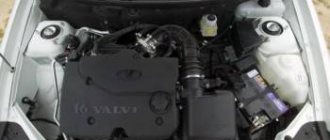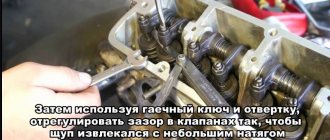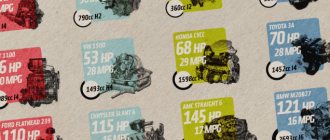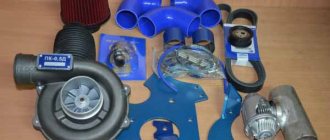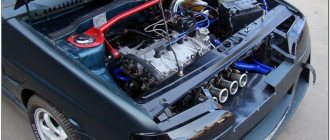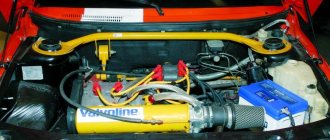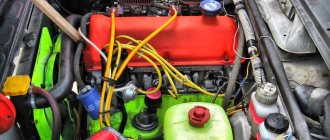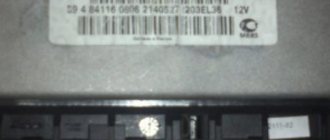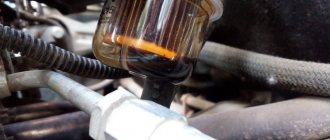Over the years, owners sometimes become so accustomed to their vehicle that they are unwilling, under any circumstances, to consider selling it and purchasing a new vehicle.
However, I also don’t really want to silently contemplate how my favorite “horse” gives in to powerful foreign cars, so the only option arises, which involves tuning the VAZ-2106 engine.
The power in the standard VAZ-2106 engine is not enough, so the owners of this vehicle often decide to tune it
Indeed, tuning a VAZ-2106 engine with your own hands is a process that requires certain knowledge, but this condition should not slow down the desire of the car owner, since on the Internet you can find a lot of useful recommendations, based on which even a novice car enthusiast can successfully tune a VAZ carburetor engine. 2106.
Tuning the VAZ 2106 engine
The VAZ “six” began to be produced back in 1976. This model is long outdated both in appearance and technical characteristics. However, to this day there are still many adherents of using such cars. Some owners try to keep the car in its original form, others equip it with modern components and mechanisms. One of the primary units that undergoes tuning is the engine. Let's look at its modifications in more detail.
Cylinder block boring
The VAZ 2106 engine does not stand out for its power, because it ranges from 64 to 75 hp. With. with a volume of 1.3 to 1.6 liters, depending on the installed power unit. One of the common engine modifications is boring the cylinder block, which allows you to increase the internal diameter of the cylinders and power. The boring process involves removing a layer of metal from the inner surface of the cylinders. However, you need to understand that excessive boring will lead to thinning of the walls and a decrease in the reliability and service life of the motor. Thus, the stock power unit with a volume of 1.6 liters and a cylinder diameter of 79 mm can be bored to 82 mm, giving a volume of 1.7 liters. With such changes, reliability indicators will practically not deteriorate.
Extreme enthusiasts can increase the cylinders to 84 mm at their own peril and risk, because no one knows how long such an engine will last.
The boring process is carried out on special equipment (boring machine), although there are craftsmen who carry out this procedure almost in a garage, and the accuracy remains questionable.
At the end of the procedure, pistons are inserted into the block, which in their characteristics correspond to the new cylinder sizes. In general, block boring consists of the following main stages:
- Removing the engine from the car.
- Complete disassembly of the power unit.
- Boring the cylinder block according to the desired parameters.
- Assembly of the mechanism with replacement of pistons.
- Installing a motor on a car.
Video: how to bore a cylinder block
Replacing the crankshaft
The engine of the VAZ “six” has a VAZ 2103 crankshaft with a piston stroke of 80 mm. In addition to increasing the cylinder diameter, you can increase the piston stroke, thereby boosting the engine. For the purposes under consideration, the engine is equipped with a VAZ 21213 crankshaft with a piston stroke of 84 mm. This way it will be possible to increase the volume to 1.65 liters (1646 cc). In addition, such a crankshaft has eight counterweights instead of four, which has a positive effect on the dynamic characteristics.
Refinement of the intake and exhaust system
Upgrading the cylinder head and manifolds, if desired, can be done by anyone who owns a “six” or another classic Zhiguli model. The main goal pursued is to increase power. It is achieved by reducing the resistance when supplying the fuel-air mixture at the inlet, i.e. by removing roughness. To carry out the procedure, the cylinder head must be removed from the vehicle and disassembled. After this, it is recommended to wash the unit. For these purposes, you can use modern means or ordinary kerosene or diesel fuel. From the necessary list of tools and materials you will need:
- drill with the ability to adjust speed;
- drill;
- flexible rod;
- rollers;
- skins of different grain sizes;
- rags;
- calipers;
- exhaust valve and set of washers for boring over 32 mm;
- graphite lubricant;
- vice.
Intake manifold
It is better to start the procedure for modifying the intake tract with the manifold, through which the channels in the cylinder head will then be bored. We carry out the work as follows:
- We clamp the collector in a vice, wrap a rag around a drill or a suitable attachment, and on top of it - overlapping sandpaper with a grain size of 60–80.
Refinement of the cylinder head
In addition to the intake manifold, it is necessary to modify the channels in the cylinder head itself, since there is a step between the manifold and the cylinder head that prevents the free passage of the fuel-air mixture into the cylinders. On classic heads this transition can reach 3 mm. Refinement of the head comes down to the following steps:
- To determine where part of the metal needs to be removed, apply lubricant or plasticine to the plane of the head in the places where the commutator fits. After this, it will be clearly visible where and how much to grind off.
In addition to boring the channels, the cylinder head can be modified by installing a tuned camshaft. Most often, car owners install a shaft from a VAZ 21213, less often - sports elements of the “Estonian” type and the like.
Replacing the standard camshaft makes it possible to change the valve timing. As a result, the engine cylinders are better filled with the combustible mixture and are also cleaned of exhaust gases, which increases the power of the power unit. The camshaft is changed in the same way as during normal repairs, i.e. no special devices are required.
Video: modification of the cylinder head and intake manifold
An exhaust manifold
The essence of modifying the exhaust manifold is the same as for the intake. The only difference is that the channel needs to be sharpened no more than 31 mm. Many people do not pay attention to the exhaust manifold because it is made of cast iron and is difficult to machine, but it is still possible. It is worth considering that the collector channel should be slightly larger in diameter than in the head. In the cylinder head itself, grinding is carried out using the method described above, and it is recommended to grind the bushings to a cone.
Main characteristics of internal combustion engine 21213
| Volume, cm3 | 1690 |
| Main fuel: | gasoline AI-92 |
| Max. power, l. With. | 83 (at 5200 rpm) |
| Max. torque, Nm | 127 (at 3000 rpm) |
| Cylinder block configuration: | in one row |
| Number of cylinders | 4 |
| Number of valves | 8 |
| Max. speed, km/h | 153 |
| Acceleration time to 100 km/h, sec. | 17 |
| Combined fuel consumption | 11,5 |
| Econorm | Russia-83 |
| Cylinder diameter, mm | 82 with deviation up to 0.05 |
| Piston stroke, mm | 80 |
| Repair dimensions of pistons and cylinders, mm: | |
| first repair (marking on the piston - triangle, on the rings - 40) | 82.4 |
| second repair (marking on the piston - square, on the rings - 80) | 82.8 |
| Repair measurement of the diameter (for boring) of the crankshaft supports | 54.52 with deviation up to 0.013 |
| Compression ratio | 9,4 |
| Supply system | two-barrel carburetor |
| Cooling | liquid |
| Valve mechanism | SOHC |
| Cylinder block material | cast iron |
| Presence of liners in cylinders | not provided for by design |
| Head material | aluminum alloy |
| Resource before major overhaul, km | 80,000 (actual ≈ 120,000 km) |
| Number of bars | four |
| Cylinder operating order | 1-3-4-2 |
| Max. speed, rpm | 8000 |
| Weight, kg: | 117 |
Also interesting: Turbocharging on the Niva’s fuel-injected engine
Compressor or turbine for the “six”
You can increase engine power by installing a compressor or turbine, but first you need to figure out what is required for this. First of all, you need to understand that, due to its design features, it is possible to install a turbine on a carburetor engine, but it is quite problematic. The nuances include both large material and time costs. The most important points to think about when equipping a car with a turbine are:
- Mandatory installation of an intercooler. This part is a kind of radiator, only the air is cooled in it. Since the turbine creates high pressure and the air is heated, it must be cooled to obtain the effect of the installation. If you don't use an intercooler, there will be an effect, but much less.
If you are not such an avid racing driver, then you should look towards the compressor, which has the following differences from the turbine:
- Does not develop high blood pressure.
- There is no need to install an intercooler.
- You can equip a VAZ carburetor engine.
To equip a VAZ 2106 with the unit in question, you will need a compressor kit - a kit that includes everything necessary for converting the engine (pipes, fasteners, supercharger, etc.).
The product is installed according to the manufacturer's instructions.
Video: installing a compressor using the “five” as an example
Turbo kit
A new model of a mechanical drive supercharger has been launched into the series. With its help, you can increase power by a third, extend the life of the power plant, and reduce gasoline consumption. The delivery element comes with all the spare parts necessary for installation.
Here are all the basic works with which you can perform tuning. Make the most suitable choice for yourself, or use all the recommendations at once. Just decide in advance what you can do yourself and what work you will involve specialists in.
16-valve engine on VAZ 2106
One of the options for tuning the “six” is replacing the 8-valve engine with a 16-valve engine, for example, from a VAZ 2112. However, the whole process does not end with a banal replacement of engines. Quite serious, painstaking and expensive work lies ahead. The main stages of this type of modification are:
- For a 16-valve engine we install an injection power system.
- We adjust the mount on the engine mounts (classic mounts are used).
- We change the crown on the flywheel, for which we knock down the old one, and in its place we put a part from a VAZ 2101 with preheating. Then we grind off the collar on the engine side of the flywheel (you will have to turn to a lathe). This is necessary for the starter to fall into place. After finishing work on the flywheel, we balance it.
From the listed points for installing a 16-valve unit, you can understand and preliminary assess your capabilities both financially and technically. If you do not have the necessary components and knowledge, you will have to seek outside help and “pour” additional funds into this type of hobby.
Video: installing a 16-valve engine on a “classic”
The “six” engine lends itself well to boosting, and it is not necessary to be a specialist with extensive experience to increase the volume of the unit. By gradually improving your car, you can end up with a fairly “peppy” car that will make you feel more confident on the road.
There are several ways to improve the characteristics of the dynamics and power of the VAZ 2106 engine. Finishing the engine itself is the main method. Engine tuning for a VAZ 2106 includes: lightening the pistons, crankshaft, connecting rods, adjusting and grinding manifolds, etc. Also a good way is to fine-tune the systems responsible for powering and igniting the engine. Don’t forget about changing the gear ratios (usually upward) and, of course, fine-tuning the chassis (springs, shock absorbers, new wheels, tires, brakes).
Tuning the VAZ 2106 engine
If you don’t have enough time, budget and don’t have the necessary equipment, but want to drive your VAZ 2106 quickly, then experimenting with the engine carburetor would be ideal. You don’t need any special engineering knowledge or tools for this.
Aluminum block and sleeves
Guys, this is a VERY broad topic, perhaps I will write about it a little later. In the meantime, I’ll let you understand a few basic postulates.
Aluminum options are indeed often not recommended to be bored (although not all of them) and this is the point. First, let’s look at the manufacturing technology of modern blocks:
“Dry liners” and SILUMAL are quite repairable, that is, if your compression has dropped due to wear from high mileage, then you can easily remove 0.5 - 1 mm, install a repair piston group and continue riding. ALSO, for some SILUMAL variants, manufacturers produce ORIGINAL aluminum sleeves; they are needed when the bore is more than 1mm. True, their cost simply goes off scale, up to 200 EUROS per one, but there is an exceptional ratio of metals and the possibility of complete restoration (also in some cases you can buy one piece for one cylinder). The only EXCEPTION can be that the block wall is very badly damaged, to a depth greater than repair boring is possible. However, such blocks may not be saved by anything; fatal damage may occur, for example, the piston has turned.
What should you prepare for?
Full tuning of the VAZ 2106 engine is a rather expensive undertaking. After all, you will have to not only change the piston group, connecting rods, crankshaft, fuel supply and exhaust gas manifolds.
All these parts must be carefully adjusted and balanced. There is no way to do this without turning to specialists who have special expensive equipment at their disposal and, most importantly, experience in carrying out such work.
It should also be understood that the cost of increasing the power of the VAZ 2106 (engine tuning) will entail a complete rework of the gearbox and exhaust system. We'll have to make more efficient brakes. If a carburetor is installed on the car, improvement work will affect both it and the ignition system. In this case, it seems advisable to completely replace the fuel injection with an injector. The engine will receive new technical characteristics, which will lead to the need to re-equip the suspension - the original springs and shock absorbers will not work adequately with a faster engine. It wouldn’t hurt to install additional struts to increase the rigidity of the body part. Without these changes, increasing engine power will not have a sufficiently pronounced effect. In addition, driving such a car will become more dangerous than before the intervention in the heart of the VAZ 2106.
What is it done for?
As I wrote before (20-30 years ago), the main task was repairs. It is worth noting that the power unit and all its main parts experience constant loads, these are cylinders, pistons, rings, crankshaft, camshaft (shafts), valves, liners, etc.
The piston has especially strong loads; it rubs against the cylinder of the block, and this process is repeated hundreds - thousands of times in just one minute. This is where maximum wear occurs, the metal of the walls is ground off, and the block begins to lose its original round shape. If you exaggerate it, it becomes oval, not round. The fit of the pistons (namely its rings) to the walls begins to deteriorate, accordingly, the combustible mixture or exhaust gases begin to flow into the crankcase, and oil, on the contrary, into the working chamber - the power drops, the power unit begins to “eat oil”! Gray (bluish) smoke begins to fly from the muffler . These are the first bells.
Engine tuning: installation of forged pistons
When working to increase engine power, the original cast pistons are often replaced with forged ones.
This is done for one purpose - to reduce the load. A forged piston is lighter than a cast piston. In addition, under heavy loads (the higher the speed, the higher the load on engine parts), casting behaves an order of magnitude worse than forged metal. Along with replacing the pistons, it makes sense to change or lighten the connecting rods. This process is more complex - the accuracy of removing excess metal must be at least 0.1 grams. But this procedure is less profitable than a complete replacement with H-shaped forged connecting rods, which are longer than the original ones.
Such a part is much lighter and stronger, and the latter factor will increase the compression ratio in the combustion chamber. With a long connecting rod, it is recommended to use pistons with a reduced compression height. The result of such work is boosting the engine.
Boring the cylinder block. Why do you need an engine and can you do it yourself + detailed video
I often receive questions on my blog regarding the power unit, namely its boring. It is not entirely clear to beginners why this process occurs at all, what it gives and how many times it can be done. Personally, when I personally overhauled the engine, we had to sharpen the block and then “sleeve” it, all this happened on my MOSKVICH 2140. In modern realities, with a completely different level of lubricants and coolants, such repairs are VERY rare, now this is done more for tuning, but everything is in order...
First, a little definition
Block boring is the process of physically grooving the walls of the engine cylinders (on special machines) to restore the correct (almost ideal) geometric shape.
It is done during major engine repairs , or for tuning, mainly to increase power.
Crankshaft balancing
Having lightened the connecting rod and piston group, it is necessary to balance it with the flywheel, pulleys and preferably with the clutch basket. In this case, it is better to replace the original crankshaft with a fully counterbalanced one - it is heavier, but for this part the more important parameter is strength. The lack of balancing of this system will not allow full operation of the updated VAZ 2106 engine. Engine tuning must be carried out taking into account the complete coordination of the new parts with each other, otherwise the replacement will not lead to the desired result, but will only cause disappointment.
Many things can be done yourself - this will reduce the cost of conversion and give you the right to say that you did everything yourself. But such tuning of the VAZ 2106 engine with your own hands can only be done by a limited circle of motorists, so do not hesitate to contact them for those works where accuracy is important.
Boring the block “under the mirror”
This is one of the types of boring that is the most popular. Firstly, this procedure is simple and does not require much time. Secondly, an ideal fit of the piston rings is ensured, as a result of which the friction force is almost zero. But do not forget that boring a VAZ cylinder block, for example, is carried out during a major engine overhaul. This means that, in addition to this procedure, it is necessary to replace all units that are directly or indirectly related to the sleeve.
It is imperative to replace pistons with a diameter equal to that which the liner will have after boring. Rings are installed on the pistons. Their diameter should also be different. All these new sizes are called “repair”. You can find out the current part number by looking at its body. For example, it is applied to the engine block, and it is also on the pistons. The repair may take an indefinite period of time, and you won’t be able to do all of its stages yourself; you’ll have to turn to specialists.
Expansion of fuel supply channels
When converting the lower part of the engine, you should not ignore the camshaft and valves. The power of the motor directly depends on the quality operation of this unit. For a more productive supply of the fuel mixture, it is necessary to expand and polish the channels through which it flows. First, the intake manifold is bored, then the supply channels in the cylinder head itself are bored. As you bore deeper into the head, it will be necessary to cut off the guide pins and polish the channel. After carrying out this procedure with all channels, it is necessary to polish the supply line from the valve seat side. When doing this, care must be taken not to damage the saddles.
How to increase the compression ratio
The easiest way to increase the compression ratio is to reduce the volume of the compression chamber . To do this, grind the lower plane of the cylinder head (reducing its height).
A more effective way is to replace the pistons and bore the cylinders for them . This method increases the compression ratio and increases engine displacement.
The compression ratio is also affected by the installation of camshaft tuning, which allows you to improve the geometric indicators of the compression ratio by delaying the closing of the intake valves.
Riding ramparts
The top shafts allow the engine to maximize its performance at high speeds. Installing such an element will allow you to shift the “red” speed zone, thereby allowing the engine to produce the highest torque in this range. This is achieved thanks to wider and more powerful cams on the shaft. They push the valves much better and open them more and longer than cams on a classic shaft. At the same time, the engine will exhibit unstable operation at idle speed. The problem is solved by reprogramming the electronic ignition system controller. If a “sports” camshaft is installed, the ignition system will also have to be replaced with more modern equipment.
Fuel supply system
When doing deep tuning of the VAZ 2106 engine, it is advisable to replace the carburetor with an injection fuel supply system. You can install a more productive Solex carburetor, select jets, etc. But the point is that this car unit is very capricious.
Its operation is affected by the quality of gasoline, the atmospheric air supplied to the system, and even the location of the car relative to a horizontal surface. By installing the injector, you will notice many new positive qualities in your car, namely:
- Mixing of fuel and air occurs directly in the combustion chamber, which allows you not to lose up to 10% of engine power.
- The increased dynamics of the car is due to sensor monitoring - when the load changes, injection is instantly regulated.
- No need to warm up in winter, easier starting compared to carburetor cars.
- High reliability and long service life.
- Greater environmental friendliness.
- In 1.5-2 years you will fully recoup the cost of the injector due to the saved fuel.
Installation of this system can be done by yourself. The main thing is not to forget to lay another fuel line for the return.
And don’t forget about one more thing when tuning the engine on a VAZ 2106: the throttles must be replaced with a throttle unit, into which the corresponding dampers and idle air control are installed.
Oil pump work
Due to the low engine efficiency and low wear resistance, mechanical tuning of the Niva 4x4 engine is almost mandatory. Such work is called work to change the geometry of the power plant. You should start modifying the power plant by upgrading the carburetor. We do the following:
If there is dirt or carbon deposits in the carburetor, we clean it manually. To do this we need a rag, gasoline and physical strength. If the dirt is very stubborn, a high-pressure cleaner or other device designed for washing the car will help. You can also use special “baths” to remove dried dirt from parts. In this way, the fuel supply to the gas distribution mechanism can be significantly improved.
If you are the owner of an injection Niva, then independently modifying the injector is unacceptable. Only a professional with knowledge of software can perform such tuning of the Niva engine.
Lubricant supplied through the oil pump extends engine life. To improve the performance of the oil pump when tuning the Niva engine, you need to take another pump and cut off part of the housing with the parting plane from it. The thickness of this “pancake” should be about 11 cm. Using milling, cut off the excess and leave a thickness of 10 mm.
Next, do the following to remove chamfers on the edges of the teeth:
Let's start working on the body. To do this we do the following:
This sequence will prevent the gears from turning relative to each other. You can also improve the oil receiver of the Vase by cutting it a centimeter from the bottom. After this, we adjust the end gap and connect the entire structure with bolts.
Re-equipment of the vehicle chassis
What else should you pay attention to when converting your VAZ 2106? Engine tuning and chassis tuning should complement each other. It is impossible to leave the driving characteristics of a car unchanged by installing a more advanced and powerful engine. Both the gearbox and the rear axle gearbox must be changed. The gear ratio of the driving pairs of units must correspond to the new capabilities of the engine, otherwise they will quickly fail.
The brake system needs to be improved first. In such cases, ventilated discs are installed on the front wheels, and the rear drums are replaced with disc brakes.
They are much more reliable and productive than drum ones. The caliper is installed from a VAZ 2108, brake discs are of the ATE 412125 type. The most difficult part of the installation is adjusting the axle shaft to the mounting diameter of the disc. The caliper is mounted in the same way as the front brakes. When installing the axle shaft, the bearing should be replaced with SKF. The new system is connected to the old highway. In addition, the brake master cylinder needs to be replaced with a foreign-made product.
Having rebuilt the entire brake system, pay attention to the suspension. New machine capabilities require stiffer shock absorbers and reinforced springs. To enhance the rigidity of the body, it is advisable to install special spacers. One is installed in the engine compartment of the car, increasing the rigidity between the side members of the car and the seats of the front pillars. The second is mounted in the luggage compartment and fixes the geometry of the rear shock absorber and spring seats.
Separately, it is worth noting the steering system of the car. Strengthening the anti-roll bar will help make the steering wheel more rigid.
This is achieved due to a slightly shortened stabilizer of the same type, which, with the help of individually made fasteners, increases the rigidity of the standard one many times. Yes, you will have to tinker, but you will be pleasantly surprised by the behavior of your car on the road.
Repair dimensions of cylinders and pistons of the VAZ 21213 engine during major repairs
| Repair cylinder size, mm | Piston and cylinder class | Piston diameter, mm | Cylinder diameter after boring, mm | Cylinder diameter after honing, mm |
| 1 repair | ||||
| 82,4 | A | 82,34-82,35 | 82,37-82,38 | 82,40-82,41 |
| B | 82,35-82,36 | 82,38-82,39 | 82,41-82,42 | |
| C | 82,36-82,37 | 82,39-82,40 | 82,42-82,43 | |
| D | 82,37-82,38 | 82,40-82,41 | 82,43-82,44 | |
| E | 82,38-82,39 | 82,41-82,42 | 82,44-82,45 | |
| 2 repairs | ||||
| 82,8 | A | 82,74-82,75 | 82,77-82,78 | 82,80-82,81 |
| B | 82,75-82,76 | 82,78-82,79 | 82,81-82,82 | |
| C | 82,76-82,77 | 82,79-82,80 | 82,82-82,83 | |
| D | 82,77-82,78 | 82,80-82,81 | 82,83-82,84 | |
| E | 82,78-82,79 | 82,81-82,82 | 82,84-82,85 | |
Also interesting: Changing the oil in the front and rear axles of a VAZ Niva
Achieving the goal
This brings us to the end of our conversation on the topic: “Tuning the VAZ 2106 engine.” The photos presented on the page will help beginners navigate the question of what parts and components they need to pay special attention to when bringing what they want to life. As a result, the car owner receives a completely new vehicle, absolutely incomparable in technical parameters with its ancestor. A powerful engine, a sensitive gearbox, and a rigid car body allow you to actively maneuver at speeds that are accessible to this car only when driving on a straight highway. On the track, thanks to such a procedure as engine tuning, the VAZ 2106 will be able to leave far behind not only similar cars, but also some foreign cars.
